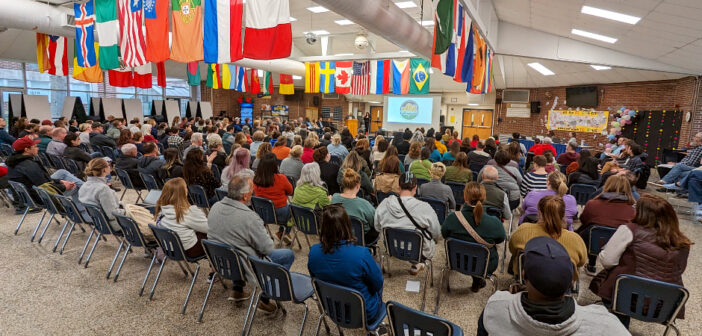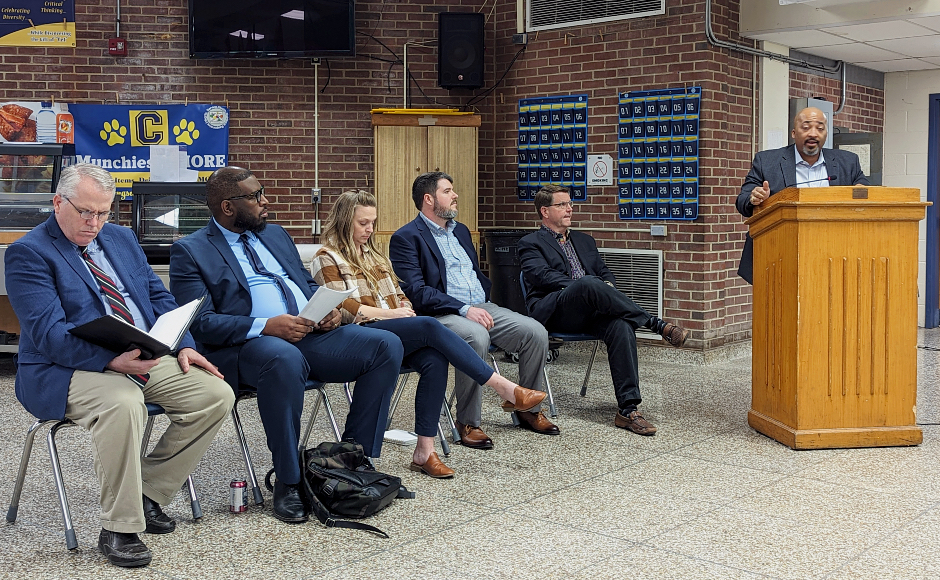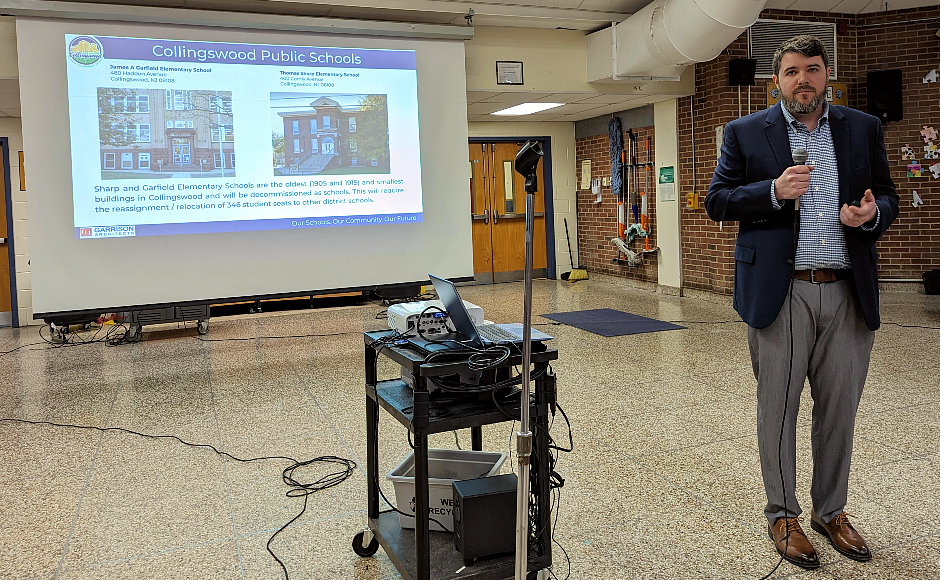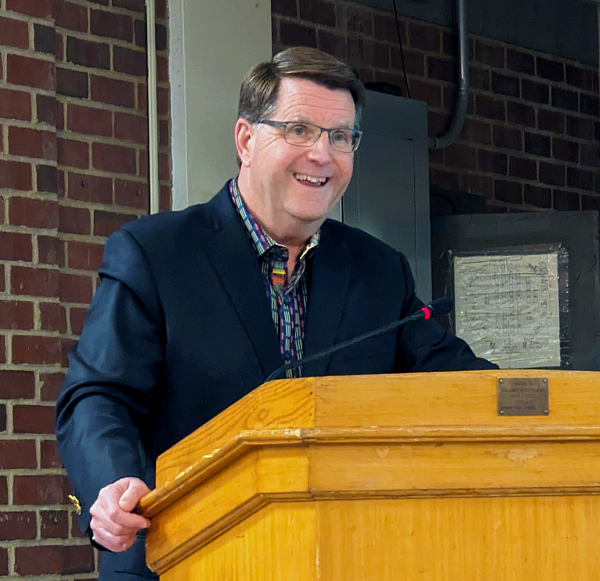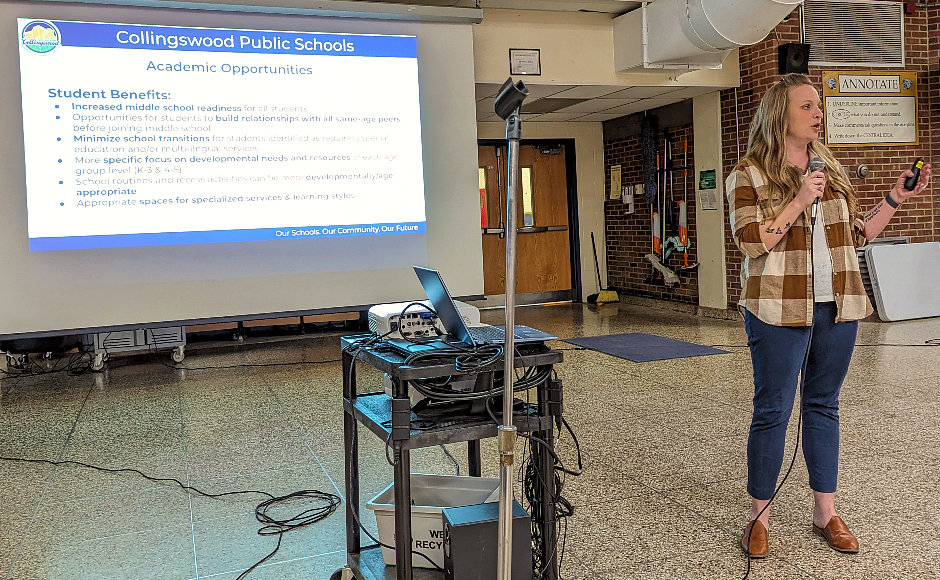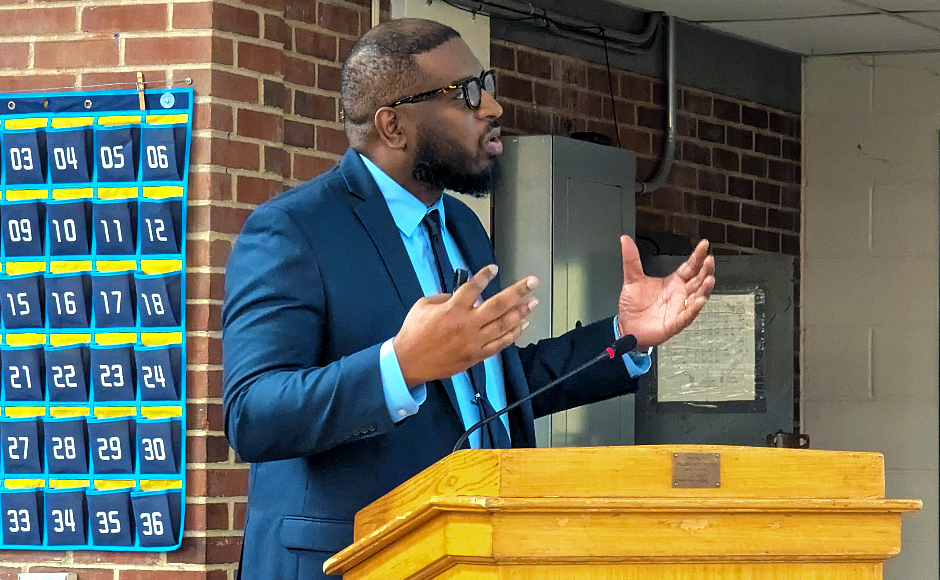At an estimated local share of nearly $40 million, the measure represents a generational transformation for the district, with building closures, grade-level realignment, and added capacity.
By Matt Skoufalos | March 27, 2024
This September, Collingswood Public Schools will put the most significant ballot initiative in a generation before voters, a $44.5-million bond measure that would dramatically transform district infrastructure in an effort to address achievement gaps, facilities needs, and student inclusion.
At an estimated 4.0 to 4.5-percent interest rate on a 30-year bond, the local share of that amount falls to $39.98 million after state aid is applied, bringing the tax impact of the measure to some $420 to $480 annually for a home assessed at the borough average value of $232,569.
The project would have the most significant impact upon the district neighborhood elementary schools, which would be realigned to educate Pre-K-to-third-grade students at William P. Tatem, Zane North, and Mark Newbie elementary schools.
Collingswood would also acquire and renovate the Good Shepherd Catholic School, which it has already been leasing for additional office space, transforming it into a fourth-and-fifth-grade elementary school building.
Under the proposal, the district also would close the Thomas Sharp and James A. Garfield Elementary Schools, the oldest structures in its inventory at 119 and 109 years, respectively. Garfield would then be sold off, with the proceeds funding the transformation of Sharp into a neighborhood community center.
The seats lost from the closures of those buildings, which house a combined 346 elementary students, would be recovered by adding six new classrooms comprising 126 seats at Zane North, and the capacity for another 300 seats through the Good Shepherd renovations; a total of 50,000 square-feet of added space. Newbie, Tatem, and Zane North would also add new, ADA-compliant playground equipment and poured play surfaces.
Finally, the bond measure would redevelop athletic and recreational fields at Collingswood High School (CHS), constructing an eight-lane track, multi-sport artificial turf field, and 1,500-seat grandstand, with press box, concessions, bathrooms, team rooms, improved lighting, and sound system. It would also reorient softball fields, add practice fields, and address drainage issues onsite.
Collingswood Superintendent of Schools Fred McDowell introduced the measure to a packed CHS cafeteria Tuesday evening as “a cohesive and aligned ask for the community to consider,” born out of more than two years of planning, strategizing, and soliciting feedback from some 1,100 community members.
Top concerns among those polled were: aging district infrastructure, improving athletic facilities, and mitigating disparities among elementary campuses, McDowell said.
“Collingswood, like most of the region, is experiencing pretty significant demographic shifts,” the superintendent said after the meeting.
“When we talk about equity and access, if we say that we believe that all children matter, our system, structure, supports, have to reflect that aspect.
“Until it does, we have a lot of work to do,” McDowell said. “If we say, as a community, that we value education, we need to have facilities that can create equitable access to the full depth of what we offer to all students. When you have academic disparities in student outcomes to double-digit percentage points, that’s a problem.
“We’re trying to create an environment where all kids win,” he said. “Currently, we’re not delivering on that. Collingswood is a diverse community, but some of our schools are not diverse. That’s what families have really been asking for.”
McDowell also spoke about borough residents paying higher and higher prices for homes in town, leading them to “have certain expectations of the schools that they attend; of the recreational facilities that they have access to.” In making the changes that the referendum would deliver, “We’re trying to meet the community’s expectations,” he said.
Aging district infrastructure — Newbie celebrates its centennial this year, Tatem and Zane are each upwards of 70 years old, and Good Shepherd, if acquired, would be the youngest building in the district at 52 years old — has only continued to deteriorate in the 19 years since the last referendum carried in Collingswood.
The last of the debt service from that project, which constructed the breezeway linking the district middle and high school buildings, will come off the books in 2030, district Business Administrator Bethann Coleman said.
Architect Bob Garrison of the Bellmawr-based Garrison Architects, which also designed the work from that 2005 referendum, spoke about the difference in state funding for renovations versus new construction costs.
The New Jersey Educational Facilities Construction and Financing Act provides 40 percent of all eligible costs, based on architectural estimates, for renovation work. But new construction is only offset by a reimbursement of about $57 per square-foot against market-rate costs of more than $500 per square-foot.
Good Shepherd — which would be treated as new construction, since it’s not currently among the district assets — would cost about $22.6 million to acquire and renovate.
But those costs are still preferable to the cost of demolishing both Garfield and Sharp, which the district believes are no longer salvageable, and rebuilding structures identical to their current footprints, which Garrison ballparked at $750 per square-foot.
“Funding for the new construction is severely handicapped because you’re starting from scratch,” he said.
In terms of its physical capacity, the district is already showing signs of being stretched to its limits, Board Member Matt Craig said.
District enrollment is at 2,260 students presently, but only has functional capacity for 2,056 students; moreover, projected enrollment for the 2026-2027 school year is up to 2,314 students, according to estimates from the New Jersey Department of Education.
“We’re making use of every inch of our buildings at the elementary level,” Craig said.
Board Member Sarah Sherman spoke about the proposal in terms of its benefits to students and faculty alike. Realigning the upper elementary grades into one educational setting can improve student academic and social readiness before middle school, she said.
Realignment also can support differentiated instruction for different learning styles and levels, help draw focus on more specific content areas, and better prepare children for standardized testing, Sherman said. It also provides dedicated spaces for art, music, and sign language instruction.
The realignment further offers the opportunity to resolve longstanding achievement gaps that have been present in neighborhood elementary schools, which are mostly a function of household wealth. It also affords the district the chance to create elementary-school environments that more accurately reflect the racial diversity of the district on the whole.
According to a presentation from Diversity, Equity, and Inclusion (DEI) Consultant Bruce Smith, the borough elementary schools, as presently composed, have 35 percent minority populations against a 65 percent white majority when averaged together.
But individually, those numbers are skewed by neighborhood, with big disparities at Zane North (80 percent white, 20 percent minority population), Tatem (70 percent white, 30 percent minority), and Sharp (60 percent minority, 40 percent white).
The proposed realignment would create a fourth- and fifth-grade population at Good Shepherd that’s projected to be split 65-35 along the broader trends seen at the current, district-wide elementary school average.
The middle school follows similar splits, at 62 percent white, 32 percent minority, but at the high-school level, the student population is split nearly evenly at 51 percent white to 49 percent minority students.
“As we’re bringing everybody together in these buildings, we’re bringing resources together,” Smith said. “This provides equal access to opportunities and resources for people who might otherwise be excluded or marginalized.”
That calculus of inclusion doesn’t just include racial and ethnic demographics. Smith outlined the shortfall in the amount of time that students with disabilities spend in a general education setting in the district (41 percent) versus the national average (66 percent) and a target of 80 percent.
“We should all be disappointed that we have schools in this district that are not ADA-compliant and that we do not have one ADA-compliant classroom,” Smith said. “We must be worthy of all of our students: our students from Oaklyn, our students from Woodlynne, and all the students from Collingswood.”
Initial reactions from those in attendance spanned a spectrum of responses from enthusiasm to outright rejection of the concept, with the most vocal objections centering on logistical and safety concerns about student commutes from neighborhoods served by the proposed shuttered buildings.
“I think it’s been a crying shame in this district for years that we do not have grade-level schools,” resident Wayne Rossi said. “There are achievement gaps in the elementary schools. Anything that moves us closer to grade-level alignment, which this plan does, is going to be a move forward.”
“Public schools are grossly underfunded,” said resident Marc Brasof. “Any time a group of educators and leaders come together to try to rebuild our schools and find money, mad props to you all.”
Resident Maggie Bosak spoke about the anxiety she has around her children’s existing school commute because of vehicle traffic along the White Horse Pike.
“As a parent who crosses those intersections every school day, I will tell you it’s terrifying,” Bosak said.
“I tend to drive because of the conditions, the concerns, and the fear of crossing these streets.
“No matter what you do, the White Horse Pike and Collings Avenue are high-traffic areas,” she said.
In addition to transportation considerations, resident Claudia Bitran wanted to learn more about the future of Sharp and Garfield in the proposal.
“Hearing that Garfield is going to be sold is not enough,” Bitran said. “Sharp as a community center is a great thing. This is an opportunity to think this through, and not leave it ‘til after the referendum.”
Resident Dorian Adams said she feared a loss of neighborhood culture with the closing of Sharp and Garfield schools.
“Schools are linchpins in social infrastructure,” Adams said. “They carry history and culture. When they close, it negatively impacts property values. It looks like we are disinvesting in West Collingswood and giving a lot of money to schools that are 80 percent white.”
Resident Zach Wright said he hoped the plan would address achievement gaps by supporting better communication among teachers in a grade-level-aligned upper elementary school.
“I think grade-level schooling is exceptionally important,” Wright said. “I’ve been an educator for 25 years, and one of the major ways to improve is through teacher collaboration. I can’t imagine being the only teacher of any kind in any building.
“One of the major things that stands in the way of school improvement in general is inertia,” he said. “Things don’t change because that’s not how things are done. But that’s not how progress is made.”
Similarly, resident Brenda Borkowski said she was optimistic about the opportunity to work through the details of the referendum.
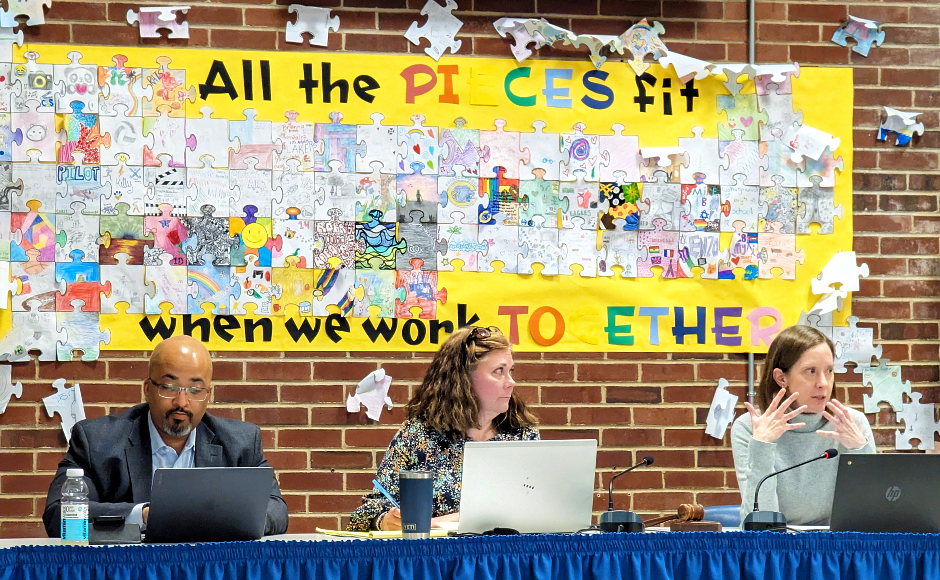
Collingswood BOE President Regan Kaiden (right), Business Administrator Bethann Coleman (center) and Superintendent Fred McDowell. Credit: Matt Skoufalos.
“I see so many solutions in this proposal to problems that I have heard in this room,” Borkowski said.
“I was not raised in Collingswood, but I hate to think of my kids and kids younger than mine doing things the way they’ve always been done just because that’s the way they’ve always been done.”
At the conclusion of the meeting, Board of Education President Regan Kaiden spoke about the ultimate decision on the project resting with the voting public, and urged people to give space to their emotions before critically considering the issues on the table.
“If the community doesn’t think that this is the way to go, the community is the one that has the voice,” Kaiden said.
“We want to take the time to honor the communities that are most affected by this,” she said. “Those communities aren’t going anywhere; they aren’t disappearing. They will be joining the larger school community.”
The district will host additional, informal, question-and-answer sessions April 9 and 16. Stick with NJ Pen for updates.
Please support NJ Pen with a subscription. Get e-mails, or follow us on Facebook, Twitter, and Instagram.

